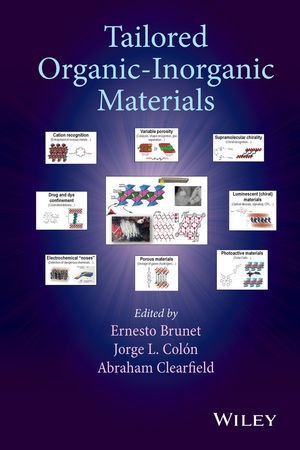Read more
This book explores the limitless ability to design new materials by layering clay materials within organic compounds. Assembly, properties, characterization, and current and potential applications are offered to inspire the development of novel materials.
* Coincides with the government's Materials Genome Initiative, to inspire the development of green, sustainable, robust materials that lead to efficient use of limited resources
* Contains a thorough introductory and chemical foundation before delving into techniques, characterization, and properties of these materials
* Applications in biocatalysis, drug delivery, and energy storage and recovery are discussed
* Presents a case for an often overlooked hybrid material: organic-clay materials
List of contents
List of Contributors xi
Preface xiii
1 Zirconium Phosphate Nanoparticles and Their Extraordinary Properties 1
1.1 Introduction 1
1.2 Synthesis and Crystal Structure of alpha-Zirconium Phosphate 2
1.3 Zirconium Phosphate-Based Dialysis Process 5
1.4 ZrP Titration Curves 7
1.5 Applications of Ion-Exchange Processes 11
1.6 Nuclear Ion Separations 11
1.7 Major Uses of alpha-ZrP 12
1.8 Polymer Nanocomposites 12
1.9 More Details on alpha-ZrP: Surface Functionalization 17
1.10 Janus Particles 18
1.11 Catalysis 20
1.12 Catalysts Based on Sulphonated Zirconium Phenylphosphonates 22
1.13 Proton Conductivity and Fuel Cells 27
1.14 Gel Synthesis and Fuel Cell Membranes 30
1.15 Electron Transfer Reactions 32
1.16 Drug Delivery 34
1.17 Conclusions 39
References 40
2 Tales from the Unexpected: Chemistry at the Surface and Interlayer Space of Layered Organic-Inorganic Hybrid Materials Based on gamma-Zirconium Phosphate 45
2.1 Introduction 45
2.2 The Inorganic Scaffold: gamma-Zirconium Phosphate (Microwave-Assisted Synthesis) 46
2.3 Microwave-Assisted Synthesis of gamma-ZrP 48
2.4 Reactions 51
2.4.1 Intercalation 51
2.4.2 Microwave-Assisted Intercalation into gamma-ZrP 52
2.4.3 Phosphate/Phosphonate Topotactic Exchange 52
2.5 Labyrinth Materials: Applications 57
2.5.1 Recognition Management 57
2.5.1.1 Chirality at Play 62
2.5.1.2 Gas and Vapour Storage 69
2.5.2 Dissymmetry and Luminescence Signalling 71
2.5.3 Building DSSCs 75
2.5.4 Molecular Confinement 77
2.6 Conclusion and Prospects 78
References 79
3 Phosphonates in Matrices 83
3.1 Introduction: Phosphonic Acids as Versatile Molecules 83
3.2 Acid-Base Chemistry of Phosphonic Acids 84
3.3 Interactions between Metal Ions and Phosphonate Ligands 87
3.4 Phosphonates in 'All-Organic' Polymeric Salts 90
3.5 Phosphonates in Coordination Polymers 96
3.6 Phosphonate-Grafted Polymers 97
3.7 Polymers as Hosts for Phosphonates and Metal Phosphonates 108
3.8 Applications 113
3.8.1 Proton Conductivity 113
3.8.2 Metal Ion Absorption 117
3.8.3 Controlled Release of Phosphonate Pharmaceuticals 119
3.8.4 Corrosion Protection by Metal Phosphonate Coatings 125
3.8.5 Gas Storage 125
3.8.6 Intercalation 126
3.9 Conclusions 127
References 128
4 Hybrid Materials Based on Multifunctional Phosphonic Acids 137
4.1 Introduction 137
4.2 Structural Trends and Properties of Functionalized Metal Phosphonates 138
4.2.1 Monophosphonates 138
4.2.1.1 Metal Alkyl- and Aryl-Carboxyphosphonates 138
4.2.1.2 Hydroxyl-Carboxyphosphonates 143
4.2.1.3 Nitrogen-funcionalized phosphonates 147
4.2.1.4 Metal Phosphonatosulphonates 149
4.2.2 Diphosphonates 150
4.2.2.1 Aryldiphosphonates: 1,4-Phenylenebisphosphonates and Related Materials 151
4.2.2.2 1-Hydroxyethylidinediphosphonates 155
4.2.2.3 R-Amino-N,N-bis(methylphosphonates) and R-N,N'?]bis(methylphosphonates) 156
4.2.3 Polyphosphonates 163
4.2.3.1 Functionalized Metal Triphosphonates 163
4.2.3.2 Functionalized Metal Tetraphosphonates 167
4.3 Some Relevant Applications of Multifunctional Metal Phosphonates 174
4.3.1 Gas Adsorption 175
4.3.2 Catalysis and Photocatal
About the author
Ernesto Brunet, PhD, is Professor in the Department of Organic Chemistry at the Autonomous University of Madrid. Formerly a Fulbright and NATO Fellow with Prof. Ernest L. Eliel at the University of North Carolina, Chapel Hill, he has worked on numerous structural and stereochemical problems that led to his interest in the building of organic-inorganic materials where the organic moieties display unusual properties within the supramolecular architecture.
Jorge L. Colón, PhD, is Professor in the Chemistry Department at the University of Puerto Rico. His research focuses on the use of layered inorganic materials in applications ranging from artificial photosynthesis, amperometric biosensors, vapochromic materials, and drug delivery systems.
Abraham Clearfield, PhD, is Distinguished Professor at Texas A&M University. He received his BA and MA from Temple University in Philadelphia and his Ph.D. at Rutgers University in 1954. He has worked extensively on layered compounds, intercalation chemistry, inorganic ion exchangers including zeolites and metal phosphonate chemistry. He has published 560 papers in peer reviewed journals, edited four books and holds about 15 patents.
Summary
This book explores the limitless ability to design new materials by layering clay materials within organic compounds. Assembly, properties, characterization, and current and potential applications are offered to inspire the development of novel materials.

